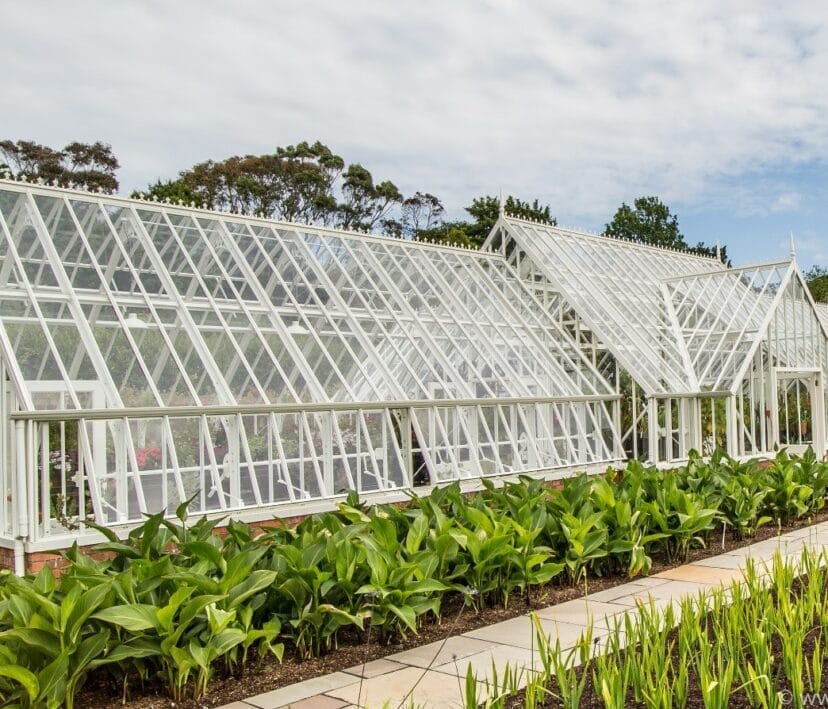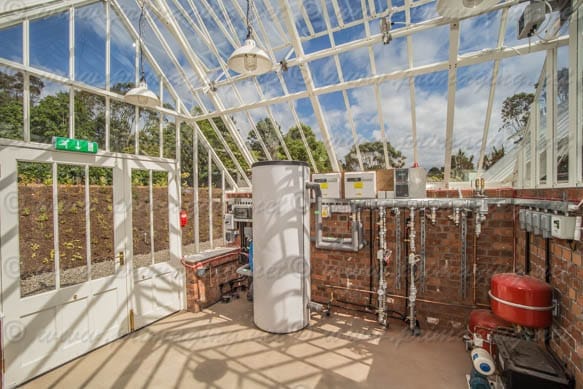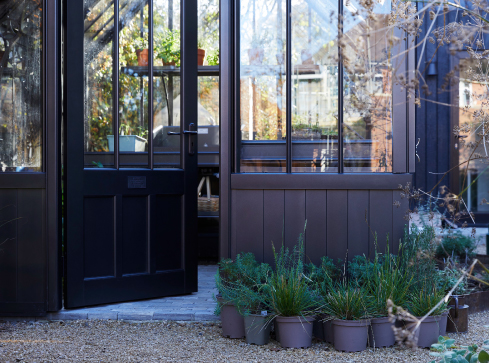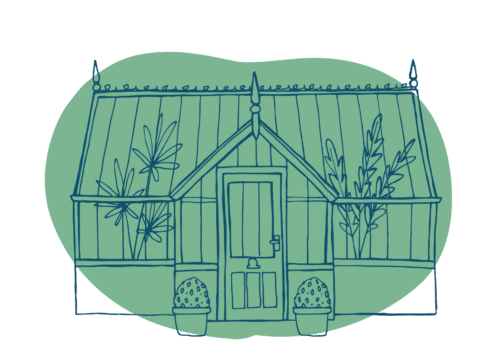
We’ve spoken with our friends at Harrier Garden Developments to get their expertise on how to heat your greenhouse in the most efficient way possible.
Why would you need to heat a greenhouse?
Heating a greenhouse allows you to extend your growing season. Starting early in the spring brings fruit and veg to the table sooner and you can continue growing well in to the winter. A heated glasshouse also allows you to over winter more tender plants such as citrus trees. The more ambitious gardener may also wish to grow tropical or sub-tropical plants but this would also require a higher temperature and perhaps humidifiers.
Background heat will also stop frost damaging pots or bursting pipes.
What do you need to consider before heating your greenhouse?
The main question is what do you want to grow? This will then determine the design temperature which along with the size of glasshouse will influence the complexity of system you require. The supplementary question is what power and heat sources are available.
What kind of heating systems are available?
In a small glasshouse, less than 15 meters square, with lower temperature requirements a fan heater is probably the most sensible choice.
 If size or temperature requirements are greater, then a more complex system is required. All the heating systems we supply work from convection of heat from a hot body in a similar fashion to a radiator system in a house. This provides a gentle convection current around the glasshouse, which is kinder to the plants than blowing hot air at them and drying out the leaves and spreading diseases. The heat can be provided electrically or via a hot water system. We would normally recommend electric up to about 8kw and hot water systems above this. The reason for this is that most domestic electrical supplies will only accommodate an 8kw load. A hot water system is usually based around an oil or gas boiler.
If size or temperature requirements are greater, then a more complex system is required. All the heating systems we supply work from convection of heat from a hot body in a similar fashion to a radiator system in a house. This provides a gentle convection current around the glasshouse, which is kinder to the plants than blowing hot air at them and drying out the leaves and spreading diseases. The heat can be provided electrically or via a hot water system. We would normally recommend electric up to about 8kw and hot water systems above this. The reason for this is that most domestic electrical supplies will only accommodate an 8kw load. A hot water system is usually based around an oil or gas boiler.
Are there any sustainable ways to heat a greenhouse?
We recognise the importance of striving to become carbon natural and hope to achieve this before the governments target date. With this in mind, we are working with our industry partners to develop more sustainable ways to heat glasshouses. We have installed heat pump systems at Logan Botanic Gardens in Scotland and at an Oxford College, as well as for a few private clients. Some larger estates are installing biomass plants and connecting their glasshouses to these, and of course solar panels can be fitted to potting shed roofs.
Reducing the volume to be heated reduces the energy required. This can be achieved by zoning larger glasshouses or fitting thermal screens. These draw across just above head height after sunset trapping the hot air below. The use of propagation benches and soil warming cables in cold frames or deep sided benching can also be considered for localised heating of plants.
How do you know what temperature you should heat your greenhouse to?
We like to talk about the “Temperature Lift” this is the difference between the night time winter low, when there is no glasshouse effect, and the target internal temperature. For the night time low we roughly split the country in two and work from -5/23 C/F in the south and -10/14 C/F in the north. This can however be affected by local conditions.
Does the size affect the heating capacity?
Yes, the bigger the internal volume the more heat required. Also, as a solid wall has better insulation properties than a single sheet of glass, so a lean to or three-quarter span is slightly easier to heat than a standalone.
Can you double-glaze a glasshouse?
Glasshouses are typically always single glazed as their main purpose is to let the light through. Each pane of glass blocks some of this important light and even a small reduction in light has a big impact on the plants. Taking figures from accurately recorded commercial glasshouses, it has been proven that a 1% reduction in light reduces yield by 1 tonne an acre over a season. Single glazing reduces light by 5-7% were as double-glazing reduces this by up to 25%.
Can you add the heating system after your greenhouse has been installed?
Yes, but it is more difficult, not least because the glasshouse is full of plants. If you are considering a retrofit to perhaps spread the cost of the project, then there are certain things that can be done to help. For example, build and fit the trench and floor grates, build in service ducts during the base build, fit an adequate power supply.
Heating controls and thermostats
A glasshouse has very different demands from a house. It will heat up quickly in the sun but loose heat quickly after dark, similarly the same thing happens in the greenhouse when the heating is turned on and off. We have developed a proprietary control system that prevents these large temperature swings. This is better for the plants and reduces cycling on the boiler, increasing efficiency and life expectancy. Our system works by gently increasing the temperature in the heating pipes as the glasshouse cools down. The controller takes a reding every 2 minutes and makes gradual changes to the valve which controls the system temperature.
We also use on most of our systems, an Aspirated Screen that measures the air temperature around the leaves of the plants. By contrast, a domestic thermostat mounted on a wall is measuring the temperature near the wall which on a sunny day will have absorbed a lot of heat and will be several degrees warmer than the air towards the front of the glasshouse on a cold night. Our controller also allows for different temperatures to be set during day and night. This is because after sunset when photosynthesis stops, the plant requires less energy and thus the temperature can be turned down a few degrees, saving on fuel costs and carbon.
Positioning of Heating Pipes
Heat rises, so we like to keep the pipes as low as possible. Ideally, they are under the floor in a heating trench with grates over. It is also an advantage to have the pipes on the walls under the benching as this helps promote strong root growth. A glasshouse cools most quickly near the glass. So having the warm air moving up the inside of the glass helps trap the warm air in the middle and avoids heat spots.
Materials and Equipment
A glasshouse is a harsh environment particularly for electrical/electronic items. All our equipment is specifically designed to work in these harsh conditions and should not use cheaper alternatives which are not as robust and indeed may prove dangerous.
If you’re looking to build your own free standing greenhouse request a brochure here or for more inspiration take a look at our bespoke greenhouses.




















